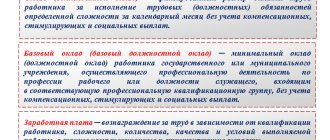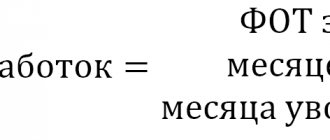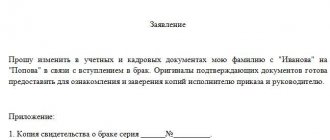Both on the Internet, in print publications, and in legal systems, there are many information materials that teach accountants how to correctly calculate vacation pay for employees in certain cases. Our material is intended for the employees themselves, for whom quite often the very procedure for calculating vacation pay and, accordingly, the estimated amount of vacation payments due to them is a mystery shrouded in darkness.
Not all employees, for example, are aware that vacation can lead to significant financial losses if taken in months such as January and May. Therefore, although it may be reasonable to add a few days of vacation to public holidays, such a choice may not be financially beneficial for the employee at all.
Below we will look at the theoretical aspects of calculating vacation payments, as well as make calculations that clearly demonstrate when it is profitable to take a vacation and when it is not at all.
This is especially true in light of the upcoming May holidays - many people prefer not to work on May 6, 7 and 8, but to take vacation on these days and get a full spring break as a result. But not everyone realizes how much it will cost them.
In addition, we will try to shed light on the confusing system of transferring weekends and their difference from holidays for the purpose of providing leave.
A little theory
The entire 19th chapter of the Labor Code (Labor Code of the Russian Federation), which is called “Vacations,” is dedicated to vacations.
Remember that paid leave must be provided to the employee annually. The right to use vacation for the first year of work arises for the employee after six months of continuous work with this employer. But by agreement of the parties, paid leave can be provided to the employee before the expiration of six months (Article 122 of the Labor Code of the Russian Federation).
Based on Article 125 of the Labor Code of the Russian Federation, by agreement between the employee and the employer, annual paid leave can be divided into parts. Moreover, at least one part of this leave must be at least 14 calendar days.
According to Article 114 of the Labor Code of the Russian Federation, employees are provided with annual paid leave while maintaining their place of work (position) and average earnings.
The duration of the annual basic paid leave in accordance with Article 115 of the Labor Code of the Russian Federation is 28 calendar days . That is, for a year of work, each employee “earns” 28 days of vacation.
Using simple calculations, it is easy to find out that for each month of work you are entitled to 2.33 vacation days (28 calendar days of vacation/12 months).
Please note: The length of service that gives the right to annual basic paid leave does not include :
- the time the employee is absent from work without good reason;
- time of maternity leave;
- time of administrative leave “at one’s own expense”, exceeding 14 calendar days during the working year.
Let us recall that, on the basis of Article 129 of the Labor Code of the Russian Federation, wages (employee remuneration) are remuneration for work.
Accordingly, wages are accrued to the employee for the time he worked, i.e. for working days. This is where the difference between salary and vacation pay lies:
- Salaries are paid for hours worked and are calculated on working days.
- Vacation pay is paid for calendar days and is calculated based on average earnings .
Vacation nuances – 2021
On the eve of the summer - the massive vacation season in 2021, you should be guided by the updated explanations of the labor department, which clarifies and adjusts the periods, prohibited days and deadlines for the payment of funds intended for vacation. When providing employees with annual paid leave, the accounting and personnel departments must take into account the following nuances:
- Date of transfer or issue from the cash register. The Ministry of Labor, by Letter No. 14-1/OOG-7157 dated September 5, 2018, clarified the timing of payment of funds for vacation. According to the explanations, the minimum period before which money must be paid in accordance with Part 9 of Article 136 of the Labor Code of the Russian Federation is three days before the start. Therefore, if an employee goes on vacation on Monday, then the amount due to the company must be paid no later than Thursday. Previously, Rostrud allowed issuance on Friday, counting the day of issue as one of three calendar days.
- Division into parts. The employer has the right to “split” rest time only with the consent of the employee, taking into account the provisions of Article 125 of the Labor Code of the Russian Federation, which contains the condition that one of the components must be at least 14 calendar days. If the employee objects to the division, the company is obliged to provide the full duration.
- Forbidden days. In order to prevent the receipt of “hidden compensation” for unused vacation rights, the Ministry of Labor in Letter No. 14-2/OOG-9754 dated December 7, 2018 introduced the following regulations:
- permission to grant the right to rest only on working days, regardless of the number, allowing one day (working);
- approval for the start of the period on a weekend;
- a ban on vacations exclusively on weekends with penalties of up to 50,000 rubles per company in case of failure to comply with the norm.
Salary calculations after vacation can be made based on days worked. An employee cannot write an application for days off to receive the “hidden part of compensation” for non-use of vacation rights.
Calculation of average earnings
Average earnings are calculated in accordance with the provisions:
- Article 139 of the Labor Code of the Russian Federation,
- Decree of the Government of the Russian Federation dated December 24, 2007. No. 922 “On the peculiarities of the procedure for calculating average wages.”
When calculating the average salary, all types of payments (regardless of their sources) provided for by the company’s remuneration system are taken into account.
Such payments include: 1. Salary, including bonuses and coefficients:
- by salary, tariffs, piecework, as a percentage of revenue, etc.,
including in non-monetary form (payment for meals for employees, etc., if this is provided for by the remuneration system).
2. Bonuses and other remunerations related to remuneration for labor.
3. Other types of payments related to wages.
Please note: All other types of payments that do not relate to wages do not participate in the calculation of average earnings.
For example, the following are not included in the calculation:
- bonuses for holidays (for example, bonuses for the New Year, March 8, etc.).
- benefits and other social payments (maternity pay, sick pay, etc.).
- present.
- material aid.
- other payments not related to wages.
In any mode of operation, the calculation of the average salary is based on the actual:
- salary accrued to the employee,
- time worked by the employee,
for the 12 calendar months preceding the period during which the employee retains his average salary.
Please note: A calendar month is considered to be the period from the 1st to the 30th (31st) day of the corresponding month inclusive (in February - to the 28th (29th) day inclusive).
When calculating average earnings, are excluded (clause 5 of Resolution No. 922), if:
- The employee was paid the average salary (including when on a business trip).
- The employee was on sick leave or maternity leave and received appropriate benefits.
- The employee was provided with additional paid days off to care for disabled children and people with disabilities since childhood (4 days off, paid by the Social Insurance Fund from the federal budget).
- In other cases, the employee was released from work with full or partial retention of wages or without payment in accordance with the legislation of the Russian Federation.
If in the previous 12 calendar months:
- the employee was not paid,
- no days actually worked (for 12 months or a longer period),
- all 12 months consist of time excluded from the calculation period (for example, the employee was on parental leave for up to 1.5 years),
then the average earnings are determined based on the amount of wages actually accrued for the 12 calendar months preceding the calculated 12 months (clause 6 of Resolution No. 922).
If an employee is on maternity leave, the average earnings for calculating vacation pay will be calculated based on the salary that the employee received before going on maternity leave and parental leave. If the employee in the previous 24 months:
- no salary accruals,
- no days actually worked,
then the average earnings are determined based on the amount of wages accrued for the days actually worked in the month in which it is calculated (clause 7 of Resolution No. 922).
That is, if an employee has only recently entered the service and has not yet worked for 24 months or was on parental leave for up to 3 years, the average earnings will be calculated based on the current salary.
If the employee:
- no salary accruals for the previous 24 months,
- there are no actual days worked in the previous 24 months,
- there are no salary accruals in the month in which average earnings are calculated,
- there are no days worked in the month in which average earnings are calculated,
then the average salary is determined based on the tariff rate or salary established for him (clause 7 of Resolution No. 922). Usually - based on the salary specified in the employment contract or staffing table.
Vacation pay calculation
Based on Article 139 of the Labor Code of the Russian Federation, the average daily earnings for paying for vacations (and paying compensation for unused vacations) are calculated for the last 12 calendar months.
By adding the amounts of wages (and other payments) for each of these months, we get the total amount of earnings, which is subsequently divided by 12 (months) and 29.4 (average monthly number of calendar days). This is how the “price of the day” for vacation payments is determined in the vast majority of cases. Please note: The collective agreement, internal regulations (or other local regulations) may provide for other periods for calculating the average salary, for example, 3 months. But the use of this method is possible only if it does not worsen the situation of workers.
This means that when establishing other periods for calculating average earnings, the accounting department must perform the calculation based on the provisions of the Labor Code of the Russian Federation and based on the provisions approved by the company and compare the obtained indicators. This is necessary in order to reasonably confirm that the situation of workers has not worsened.
Formula for determining average earnings when calculating vacation pay:
1. If the previous 12 months have been fully worked by the employee:
| Vacation day price = Amount of payments taken into account to calculate average earnings for 12 months/12*29.4. |
2. If the previous 12 months have
not been fully worked by the employee:
| Vacation day price = Amount of payments taken into account to calculate average earnings /(X*29.4 + Y*29.4/C). |
Where:
X is the number of months worked in full. Y - the number of worked in the month (months) worked (worked) incompletely. C – the total number of calendar days in the month (months) for each month (months) not fully worked.
The amount of vacation payments is determined by the formula:
| Vacation pay amount = Vacation day price * Number of vacation days. |
How to calculate vacation pay
When calculating the amount of vacation pay, you need to determine the number of days of rest required. Paid vacation is 28 calendar days during one year of work.
ATTENTION! In case of a fixed-term employment contract and seasonal work, 30 days of work are entitled to two days of rest.
Regardless of the duration of the vacation, it is paid according to a single algorithm. Each day is valued at the employee's average daily salary for the year. For persons working in the Far North, regional coefficients apply.
2.33 days of rest are accrued per month (fixed value).
With a full worked period
The calculation interval for accruals is 12 months worked. The standard formula for calculating vacation pay is as follows:
average daily earnings × number of required days of rest.
Average monthly income:
total earnings for the year / number of months / 29.3 (fixed value).
When calculating average earnings, not all periods are included. The estimated time excludes days when a person:
- temporarily disabled;
- does not perform work duties due to downtime or the fault of the organization;
- is on sick leave due to the need to care for disabled people;
- for other reasons, was released from duties and receives wages calculated based on average income.
ADVICE! According to Article No. 125 of the Labor Code of the Russian Federation, citizens have the right to divide their annual vacation into parts. The only condition is that the duration of one period must be at least 14 days.
If, before going on paid leave, an employee issues a sick leave, the rest days are extended by the number of days the certificate of incapacity is valid. In this case, the employer is obliged to accrue both sickness benefits and vacation pay.
If an employee’s salary was increased during the billing period, the employer must accrue an amount indexed to the salary increase factor:
new salary amount / old salary amount.
Taking into account the obtained coefficient, the average earnings change, according to which the amount of accruals is calculated. Depending on the month in which labor remuneration was increased, the following indexation is carried out:
- If the salary is increased during the billing period, all payments for the months before the increase are subject to indexation.
- If the salary is increased after the end of the pay period, but before the employee goes on vacation, the entire income is indexed.
- If the salary was increased after the start of the vacation, the calculated amount of vacation pay is indexed.
With incomplete hours worked
An employee has the right to go on vacation after at least six months of work in the organization. Then the period for calculating vacation pay is the actual time worked.
The number of days in an incompletely worked month is calculated by the formula:
29.3 / number of days in a month × number of days worked.
For example, a citizen’s salary is 30,000 rubles. per month, period worked - 7.5 months.
Then the amount is calculated in a number of steps:
- Number of days in fully worked months: 7 × 29.3 = 205.1.
- Number of days in an incompletely worked month: 29.3 / 30 (June) × 14 = 13.67.
- Total period worked: 205.1 + 13.67 = 218.77 days.
- Income for the period worked: 30,000 × 7.5 = 225,000 rubles.
- Average daily earnings: 225,000 / 218.77 = 1,028.47 rubles.
- Total amount: 1028.47 × 28 (rest days) = 28,797.16 rubles.
Example 1.
If we are talking about an employee who works 5 working days a week and at the same time:
- goes to work regularly and does not take long unpaid leaves.
- does not take sick leave (or very few of them).
- does not go on business trips (or they are rare and short-term).
- receives the same salary every month.
then in order to understand how much vacation pay he will receive, he just needs to take the amount of his salary and divide by 29.4, and then multiply by the number of vacation days.
Let’s say the salary of such an employee is 50,000 rubles. “clean”, i.e. this is the amount that he receives monthly “in hand” (the salary in this case will be 57,471.26 rubles)
Then the price of a vacation day will be 1,700.68 rubles. (50,000 / 29.4), and the amount of vacation pay for 7 calendar days is 11,904.76 rubles. (1,700.68 * 7).
If an employee saves vacation pay (not all companies provide this opportunity to employees), then he can take 5 days of vacation (from Monday to Friday) and then the amount of vacation pay will be 8,503.40 rubles. Thus, an employee can “save” vacation days, but at the same time lose in payments.
Below in Table No. 1 we calculate the price of a working day and the difference between a working day and a vacation day in accordance with the production calendar for 2013.
Table No. 1
| year 2013 | Number of working days | Net salary amount | Working day price | Vacation day price | Difference |
| January | 17 | 50 000,00 | 2 941,18 | 1 700,68 | 1 240,50 |
| February | 20 | 50 000,00 | 2 500,00 | 1 700,68 | 799,32 |
| March | 20 | 50 000,00 | 2 500,00 | 1 700,68 | 799,32 |
| April | 22 | 50 000,00 | 2 272,73 | 1 700,68 | 572,05 |
| May | 18 | 50 000,00 | 2 777,78 | 1 700,68 | 1 077,10 |
| June | 19 | 50 000,00 | 2 631,58 | 1 700,68 | 930,90 |
| July | 23 | 50 000,00 | 2 173,91 | 1 700,68 | 473,23 |
| August | 22 | 50 000,00 | 2 272,73 | 1 700,68 | 572,05 |
| September | 21 | 50 000,00 | 2 380,95 | 1 700,68 | 680,27 |
| October | 23 | 50 000,00 | 2 173,91 | 1 700,68 | 473,23 |
| november | 20 | 50 000,00 | 2 500,00 | 1 700,68 | 799,32 |
| December | 22 | 50 000,00 | 2 272,73 | 1 700,68 | 572,05 |
In Table No. 2, we calculate how much an employee will receive if he takes a week’s vacation in each month in 2013. From the number of working days for each month, we subtract 5 working days that the employee would normally miss when taking a 7-day vacation and calculate the amount of payments (salary + vacation pay) he will receive.
Table No. 2
| year 2013 | Number of working days worked | Salary amount for time worked | Vacation pay | Total "on hand" |
| January | 12 | 35 294,12 | 11 904,76 | 47 198,88 |
| February | 15 | 37 500,00 | 11 904,76 | 49 404,76 |
| March | 15 | 37 500,00 | 11 904,76 | 49 404,76 |
| April | 17 | 38 636,36 | 11 904,76 | 50 541,13 |
| May | 13 | 36 111,11 | 11 904,76 | 48 015,87 |
| June | 14 | 36 842,11 | 11 904,76 | 48 746,87 |
| July | 18 | 39 130,43 | 11 904,76 | 51 035,20 |
| August | 17 | 38 636,36 | 11 904,76 | 50 541,13 |
| September | 16 | 38 095,24 | 11 904,76 | 50 000,00 |
| October | 18 | 39 130,43 | 11 904,76 | 51 035,20 |
| november | 15 | 37 500,00 | 11 904,76 | 49 404,76 |
| December | 17 | 38 636,36 | 11 904,76 | 50 541,13 |
As can be seen from Table No. 2, the most “profitable” months for a vacationer are:
- April,
- July,
- August,
- October,
- December.
In September, the employee will remain “with his own people”, while vacation during all other months promises losses.
Example 2.
The situation is much more complicated if the employee, although he works on a 5-day work week, but at the same time:
- happens on long unpaid vacations.
- often takes sick leave.
- often travels for long periods of time.
- receives different amounts of salary each month.
It is very difficult for such an employee to calculate the exact amount of his income for the previous 12 months, and even more difficult to calculate the amount of calendar days attributable to this income.
In Table No. 3, we calculate the amount of average earnings for an employee who joined the company in January. Let’s assume that this employee worked the entire month of January and was absent due to illness in February and March.
Employee remuneration includes bonuses based on the results of the month.
Table No. 3
| Year | Month | Payments taken into account when calculating average earnings, rub. | number of calendar days worked in a month not fully worked | Days taken into account (column 4*29.4/number of days in a month) |
| 1 | 2 | 3 | 4 | 5 |
| 2013 | January | 50 000,00 | 29,40 | |
| 2013 | January Bonus for 1 month: | 3 318,00 | ||
| 2013 | February | 40 000,00 | 22,00 | 23,10 |
| 2013 | February Bonus for 1 month: | 2 242,00 | ||
| 2013 | March | 45 000,00 | 29,00 | 27,50 |
| 2013 | March 1 month bonus: | 2 462,00 | ||
| Total | 143 022,00 | 80,00 |
| Number of calendar days of the billing period | Average daily earnings, rub. (payment amount/number of calendar days) |
| 80,00 | 1 787,78 |
Unfortunately, calculating average earnings in the case under consideration is unnecessarily labor-intensive. Therefore, we propose to use a simplified calculation, recognizing that this will lead to some errors in the calculations. As for the “profitability” of the vacation, it will be similar to Example 1 with a greater or lesser difference.
May holidays
Let's take a closer look at the upcoming May holidays.
According to the Decree of the Government of the Russian Federation dated October 15, 2012. No. 1048 “On the transfer of days off in 2013”, due to the coincidence of non-working holidays on January 5 and 6 with Saturday and Sunday, and February 23 with Saturday, the transfer of days off is provided from Saturday, January 5 to Thursday, May 2, from Sunday 6 January to Friday May 3 and from Monday February 25 to Friday May 10.
Thus, in the coming May we are closed from May 1 to May 5 inclusive and from May 9 to May 12 inclusive.
May 6, 7 and 8 are working days.
In total, May has 31 calendar days, 18 working days, 2 holidays and 11 weekends.
Two holidays are May 1 and May 9 (Article 112 of the Labor Code of the Russian Federation). All other days are a transfer of weekends and are not considered as holidays from the point of view of labor legislation. This circumstance is important, since in accordance with Article 120 of the Labor Code of the Russian Federation, non-working holidays falling during the period of annual paid leave are not included .
Weekends are a completely different matter. They are included in the number of calendar days of vacation. Accordingly, if an employee writes an application for vacation from May 1 to May 10, then he uses 8 calendar days of vacation (May 1 and 9 will not be included in the number of vacation days). Of these, 3 days will be on weekdays and 5 on weekends.
From the point of view of vacation payments, this is a more pleasant option. However, it is completely unsuitable for the majority of workers who value the vacation days themselves. Thus, to save vacation days, a vacation application can be written for May 6, 7 and 8 - 3 days.
In Table No. 4 we present the calculation of “losses” for this choice, using the data from Example No. 1 (salary 50,000 rubles “net”, price of a vacation day 1,700.68 rubles).
Table No. 4
| year 2013 | number of working days in a month | salary amount | working day price | number of working days worked | Salary amount for time worked | Vacation pay (1,700.68*3) | Total "on hand" | Difference (salary - total "in hand") |
| May | 18 | 50 000,00 | 2 777,78 | 15 | 41 666,67 | 5 102,04 | 46 768,71 | 3 231,29 |
As can be seen from the table above, the “cost” of a May vacation for 3 working days will be 3,231.29 rubles.
Now let’s consider another option for combining a short vacation and the May holidays - 2 days of vacation are taken at the end of April (29 and 30). Thus, the last 2 weekends in April are added to 2 vacation days and to the 5 days of the first May holidays. The result is a 9-day vacation, as well as saving money and 1 vacation day.
The calculation of the “cost” of such a vacation is presented in Table No. 5.
Table No. 5
| year 2013 | number of working days in a month | salary amount | working day price | number of working days worked | Salary amount for time worked | Vacation pay (1,700.68*2) | Total "on hand" | Difference (salary - total "in hand") |
| April | 22 | 50 000,00 | 2 272,73 | 20 | 45 454,55 | 3 401,36 | 48 855,91 | 1 144,09 |
As can be seen from Table No. 5, the “cost” of an April vacation for 2 working days will be 1,144.09 rubles. (plus one vacation day is saved at a cost of 1,700.68 rubles), which is much more profitable than the May vacation:
- savings on payments RUB 2,087.20. + vacation day savings RUB 1,700.68. = 3,787.88 rub. saving everything.
Choose your vacation dates to your advantage!
Non-working days in May 2021
Initially, the production calendar included weekends from 1 to 3 and 8 to 10 May.
Four days between these holidays and weekends had to be worked.
However, Vladimir Putin declared May 4 to May 7 non-working days:
“In order to maintain the trend of reducing the spread of the new coronavirus infection (COVID-19), strengthening the health of citizens of the Russian Federation, and in accordance with Article 80 of the Constitution of the Russian Federation, non-working days have been established from May 4 to May 7, 2021 inclusive, with wages retained for employees.”
The production calendar does not change and the norm of working days in May does not decrease.
According to working time standards in May 2021: a total of 31 days, 19 working days, 12 holidays.
Previously on the topic:
Payment for May holidays - 2021 and production calendar for May







